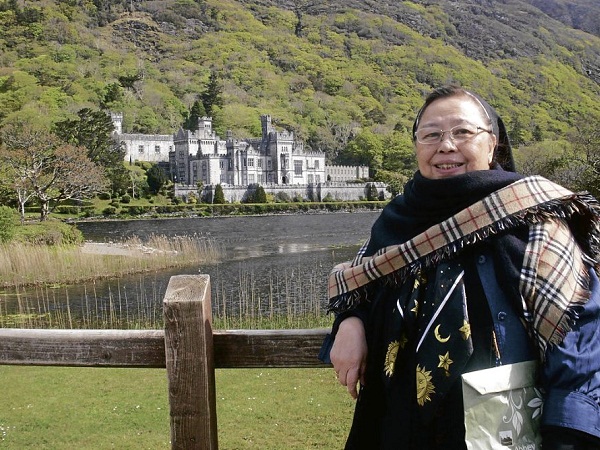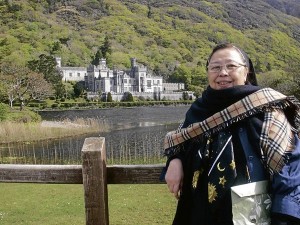
After eight years as Prioress of the Missionary Benedictine Sisters of the Manila Priory, I was taking a six-month sabbatical in Europe. My first stop: Ireland, where I’d be taking a one-month course at All Hallows College in Dublin.
On April 22, my niece Mannel (Filipino) and her husband Dan (British), both Canadian citizens now working as chefs at Four Seasons Hotel in Dublin, picked me up from the airport and brought me to the Dominican Sisters with whom I’d be staying.
That night they brought me to dinner at Four Seasons where we had gourmet fine dining—five courses of exquisite dishes. That was my first supper in Dublin!
The next day was my first class in All Hallows, supposedly a 10-minute walk away from the Dominicans (for Irish legs), but which took my Filipino legs 25 minutes to negotiate.
The first day was introduction. We were 21 participants from eight countries, mostly Sisters (who were senior citizens). Main theme of the course was “Watering Our Roots,” and we had two or three resource persons every day. So far we had had two resource persons on Irish poets, one on the Easter liturgy, two on personality dynamics, forgiveness and healing, conflict resolution, one on meditation and Irish chants, one on justice.
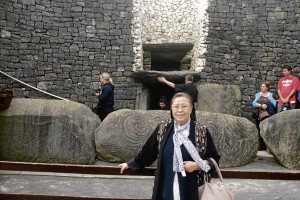
We had a student ID which gave us discounts on transportation tickets, museum entrance fees, etc. I made my first trip to the town center. By the way, Dublin is quite small and has no skyscrapers! The tallest building has only 14 stories. It is nice because the sky is visible everywhere, it is not polluted and there is a quaint atmosphere with the old buildings and small shops.
I did a city tour with what they called hop-on and hop-off bus, which meant one could stop anywhere and hop on again. I did the whole round first, which passed through Trinity College, Ireland’s oldest university; the National Library and National Museum; St. Stephen’s green, which is a beautiful garden; Temple Bar, a pedestrian tourist area; Dublin Castle; Christ Church, a beautiful Gothic cathedral (evangelical); St. Patrick’s Cathedral (Anglican); Guinness Brewery (said to be the biggest brewery in the world); the Museum of Modern Art, and Kilmainham Jail, where many Irish patriots were imprisoned.
The most beautiful stop was Phoenix Park, the biggest city park in Europe, where the residences of the American ambassador and the president of Ireland are located.

I went back to the Trinity College to see the Book of Kells—a beautifully illuminated manuscript of the New Testament. I also went to the National Museum of Archaeology to survey the prehistory of Ireland. Following the tourists, I also had my picture taken with the statue of Molly Malone at a street corner.
I find the Irish people very likeable. When I ask people for information, they insist on accompanying me a part of the way. A woman who was jogging even interrupted her run to go up the bus to ask the driver whether the bus was going where I wanted to go.
The Filipinos here don’t feel any discrimination, whether blatant or subtle. I think it is because the Irish people have suffered poverty and colonial and neo-colonial oppression under the British. And now from the European Union—at least the Sinn Fein thinks so.
Weekend jaunts
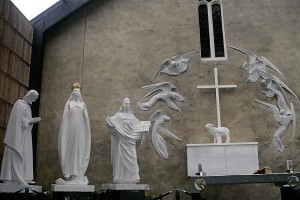
I make use of my weekends to see other cities. The first excursion I made was to Kylemore Abbey in West Ireland. I had the most wonderful weekend. I took the 3 p.m. train from the Heuston station and arrived in Galway at 5:05. I had to get another bus to go to a place called Letterfrakt where Sr. Maire Hickey, the Abbess, is supposed to collect me (as they say here; do you know they use “fetch” only for dogs?).
We went towards the mountains, which are all limestone, and the scenery was desert-like, full of bushes called gorse that have yellow flowers. There are also many lakes.
Finally I arrived at Letterfrakt and there Sr. Maire was waiting for me. She brought me to the “farm house” where I met the other Sisters. But after prayer and supper, Sr. Maire said my room was in the castle! Yes, I lived in an honest-to-goodness castle for three days.
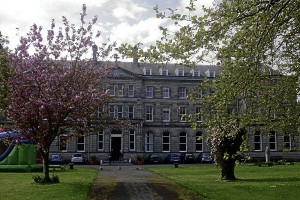
This Benedictine Abbey was actually a castle built by a rich British businessman-politician in 1867 for his wife and nine children in a 15,000-acre estate. It took 100 workers and four years to complete, and it has 70 rooms and 33 bedrooms. The public rooms have very high ceilings, royally decorated and elegantly furnished. But in 1870, when the whole family went on vacation in Egypt, the wife, Margaret, caught a disease and died there.
Heartbroken, the politician-businessman brought back the body of his wife to Kylemore and built a small, exquisite neo-Gothic chapel in her memory. But he never recovered and the estate went into debt and was sold. He died in 1910 and his body was placed beside his wife in the chapel in Kylemore Abbey.
The estate fell into disrepair and, in 1920, the Benedictine nuns, who used to be called Irish Dames of Ypres in Netherlands and who had to return to their native land because of the war, bought the estate and transformed it into an abbey. They established an elite international boarding and day school for girls. This school was closed in 2010 after the last 10 girls graduated.
Popular Kylemore abbey
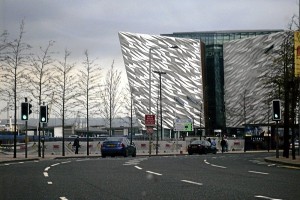
Kylemore abbey remains a popular tourist spot and is visited annually by 250,000 tourists. It is popular because the location is unbelievably beautiful, with the castle nestling at the foot of the mountain and is mirrored on the lake in front of it. It is like an oasis in that mountainous region. It has also beautiful Victorian gardens with colorful flowers and trees.
The gift shop is enormous, elegant and expensive. It has a café and a teahouse. The shop is rented by an outside firm but it sells the Sisters’ products—jams, herbal soap, chocolates, candles, all beautifully packaged.
The second excursion I made was to another popular tourist spot: The Ring of Kerry at Killarney. I have a classmate, a Mercy Sister, who arranged that I stay with the Mercy Sisters there. They are only four Sisters, mostly retired, two nurses and two teachers. Now they help either in the parish or in a nursing home.

I took the train and Sr. Regina, the superior, picked me up from the station. Then after supper, she brought me to the Killarney lake which has an upper, middle and lower levels. We went to the middle one and the view was simply marvelous. We walked along the lake to the ruin of Mor castle. Ireland has so many castles and monasteries, many of them already ruins.
Then she brought me to Ross castle, which is a bigger one. One can actually go in and have a tour but it was already closed. But nearby there is a stream full of ducks and the sunset when I was there was so glorious a group of photographers were taking pictures of it.
Kerry Ring tour
The next day I went on the famous Kerry Ring tour. I cannot describe in words the spectacular views of mountains and lakes we saw. We stopped at the so-called Famine Village or Kerry Bog Village museum. It is a compound of old houses usually found in villages—a cutter’s house, a blacksmith’s house, a laborer’s cottage, a thatcher’s dwelling.
One gets an idea how they used to live in the villages before. The famine in Ireland started in 1845 when a pest invaded the potato farms which was the main crop of the Irish. It is said that the population of Ireland went down from eight million to six million; one million died and one million emigrated to other places, especially in the Americas. We passed a so-called Silent Village because all the people there died of the famine.
We also passed by the Sheepdog Trainer’s show. The Trainer showed us how the sheepdogs could fetch the sheep from far away, guiding them to the left or to the right according to the signal of the trainer by a kind of a whistle. It was unbelievable how focused the dogs were, always waiting for the next signal.
The next day I went to the Muckross house, a castle built by Henry Herbert, then was bought by a Mr. Vincent. But it is famous really for having been the place where Queen Victoria stayed when she visited Killarney in 1861. She, the prince consort Prince Albert, the Prince of Wales and three more children came to visit.
They showed us where Queen Victoria slept—not in the royal suite but downstairs in the room of Mrs. Herbert because she was afraid of fire!
The castle is like all castles, but what I found interesting is that in the servants’ quarters there are 32 bells hanging on the ceiling on one wall attached to each bedroom. So when one of the bell rings, the servant knows where to go to ask what the occupant needs.
Northern Ireland
On my last free weekend, I went to Belfast. I stayed with the Daughters of Charity. I arrived on a Friday afternoon and at once, Sr. Bernadette gave me a historical tour.
She drove me around, showing me the murals almost at every corner commemorating people who have been killed on those spots before the Northern Ireland peace pact in 1994. She brought me to a survivor who was shot but lived, having now a titanium scalp and crutches. But the priest and another young person who tried to help him were shot by another sniper and killed.
Sister Bernadette said those were very tense times and one did not know when shootings will begin and when British soldiers would go to a house and simply ransack the whole place, slashing mattresses and sofas and dragging the men away in the middle of the night.
She also brought me to Bombay street where whole tenements were burned and where there is now a memorial park.
Behind this park is the so-called “peace wall” which runs along for miles, dividing the Protestant quarters from the Catholic quarters.
The next day Sr. Patsy brought me on a scenic tour along the northernmost part of Ireland to the Great Causeway. The scenery is unbelievably beautiful—not only the mountains and “Sound of Music”-like valleys, but the Atlantic ocean which mirrored the bluest of blue skies. Once in a while you would see a cove with very white sand.
The Great Causeway itself is hard to describe. These are walls along the coast which are made of very interesting rock formations, like sculptures and giant chocolate bars.
Along the route there are narrow roads leading down to the sea. Following one such road, we came upon a very picturesque café where we ate rhubarb cake and drank tea. On our way home a beautiful orange bird flew across a windshield.
This visit changed my impression of Belfast as a urban battleground. The city is actually beautiful, with the mountains surrounding it and its hilly streets akin to San Francisco.
Legends
On our last week, our class made an excursion to the famous Glendalough pilgrimage place. It is actually the ruins of a monastic village which traces its origin from St. Kevin, who lived in the 5th century.
There are many legends about St. Kevin. One is that one day he was praying with arms outstretched and a bird laid eggs on his palm. It is said he did not change position until the eggs hatched!
The place was awesome. It has an atmosphere of sacredness like Macchu Picchu. There are beautiful Celtic crosses, small churches and a round bell tower and a most beautiful lake so serene that, like a mirror, and it reflected the trees on both sides.
Another sacred place I visited, which is older than Glendalough, in fact older than the pyramids of Egypt or the Stonehenge, is the New Grange, a Celtic tomb which was discovered in the 1960s. It is huge mound covered by grass. When you enter, you have to crouch. At the end of the passage, there are three small caves.
The entrance to the tomb is so built that on the winter solstice, the sun’s rays go straight into the cave through a small opening at the entrance and illuminates the passage up to the caves. It is a testament not only to the engineering skills of the people of the megalithic period but of their faith in their deity. They had spent all their lives to build the tomb, which took more than their lifetimes to finish!
I celebrated my favorite feast of Pentecost at Bolton Abbey in the town of Moone. This abbey is in the midst of a huge huge farm full of cows, trees, wheatfields and two ponds with two swans, six baby swans and three ducks.
The silence here was awesome. I prayed with the monks all their prayers except for the Matins at 4:15 a.m. I learned to chant the psalms one octave lower. I just realized that men sing one octave lower. I took long walks along the stream and visited the ponds and the swans every day.
But all good things must end. And I have to leave this beautiful land. However, the memory of its green meadows, lakes and mountains, and the kindness and generosity of its people, will forever remain with me.

